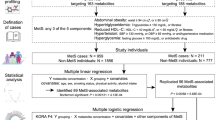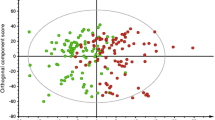Abstract
Introduction
Type 2 diabetes (T2D) is a multifactorial disease resulting from a complex interaction between environmental and genetic risk factors. Metabolomics provide a logical framework that reflects the functional endpoints of biological processes being triggered by genetic information and various external influences.
Objectives
Identification of metabolite biomarkers can shed insight into etiological pathways and improve the prediction of disease risk. Here, we aimed to identify serum metabolites as putative biomarkers for T2D and their association with genetic variants in the Korean population.
Methods
A targeted metabolomics approach was employed to quantify serum metabolites for 2240 participants in the Korea Association REsource (KARE) cohort. T2D-related metabolites were identified by statistical methods including multivariable linear and logistic regression, and were independently replicated in the Cooperative Health Research in the Region of Augsburg (KORA) cohort. Additionally, by combining a genome wide association study (GWAS) with metabolomics, genetic variants associated with the identified T2D-related metabolites were uncovered.
Results
123 metabolites were quantified from fasting serum samples and four metabolites, hexadecanoylcarnitine (C16), glycine, lysophosphatidylcholine acyl C18:2 (lysoPC a C18:2), and phosphatidylcholine acyl-alkyl C36:0 (PC ae C36:0), were significantly altered in T2D compared to non-T2D subjects (after the Bonferroni correction for multiple testing with P < 4.07E − 04, α = 0.05). Among them, C16, glycine, and lysoPC a C18:2 were independently replicated in the KORA cohort. Alterations of these metabolites were associated with ten genetic loci including six that were previously implicated in T2D or obesity.
Conclusion
Using a targeted-metabolomics and in combination with GWAS approach, we identified three serum metabolites associated with risk of T2D in both the KARE and KORA cohort and discovered ten genetic variants in relation to the identified metabolites. These findings provide a better understanding to develop novel preventive strategies for T2D in the Korean population.

Similar content being viewed by others
References
Adams, S. H., Hoppel, C. L., Lok, K. H., Zhao, L., Wong, S. W., Minkler, P. E., et al. (2009). Plasma acylcarnitine profiles suggest incomplete long-chain fatty acid beta-oxidation and altered tricarboxylic acid cycle activity in type 2 diabetic African-American women. Journal of Nutrition, 139(6), 1073–1081. doi:10.3945/jn.108.103754.
Alberti, K. G., & Zimmet, P. Z. (1998). Definition, diagnosis and classification of diabetes mellitus and its complications. Part 1: Diagnosis and classification of diabetes mellitus provisional report of a WHO consultation. Diabetic Medicine, 15(7), 539–553. doi:10.1002/(SICI)1096-9136(199807)15:7<539:AID-DIA668>3.0.CO;2-S.
American Diabetes, A. (2014). Standards of medical care in diabetes–2014. Diabetes Care, 37(Suppl 1), S14–S80. doi:10.2337/dc14-S014.
Bain, J. R., Stevens, R. D., Wenner, B. R., Ilkayeva, O., Muoio, D. M., & Newgard, C. B. (2009). Metabolomics applied to diabetes research: Moving from information to knowledge. Diabetes, 58(11), 2429–2443. doi:10.2337/db09-0580.
Boender, A. J., van Rozen, A. J., & Adan, R. A. (2012). Nutritional state affects the expression of the obesity-associated genes Etv5, Faim2, Fto, and Negr1. Obesity (Silver Spring), 20(12), 2420–2425. doi:10.1038/oby.2012.128.
Calvert, G. D., Graham, J. J., Mannik, T., Wise, P. H., & Yeates, R. A. (1978). Effects of therapy on plasma-high-density-lipoprotein-cholesterol concentration in diabetes mellitus. Lancet, 2(8080), 66–68.
Cho, Y. S., Go, M. J., Kim, Y. J., Heo, J. Y., Oh, J. H., Ban, H. J., et al. (2009). A large-scale genome-wide association study of Asian populations uncovers genetic factors influencing eight quantitative traits. Nature Genetics, 41(5), 527–534. doi:10.1038/ng.357.
Czyzyk, T. A., Andrews, J. L., Coskun, T., Wade, M. R., Hawkins, E. D., Lockwood, J. F., et al. (2013). Genetic ablation of myelin protein zero-like 3 in mice increases energy expenditure, improves glycemic control, and reduces hepatic lipid synthesis. American Journal of Physiology Endocrinology and Metabolism, 305(2), E282–E292. doi:10.1152/ajpendo.00228.2013.
Floegel, A., Stefan, N., Yu, Z., Muhlenbruch, K., Drogan, D., Joost, H. G., et al. (2013). Identification of serum metabolites associated with risk of type 2 diabetes using a targeted metabolomic approach. Diabetes, 62(2), 639–648. doi:10.2337/db12-0495.
Go, M. J., Hwang, J. Y., Kim, Y. J., Oh, H. J., Kim, Y. J., Kwak, S. H., et al. (2013). New susceptibility loci in MYL2, C12orf51 and OAS1 associated with 1-h plasma glucose as predisposing risk factors for type 2 diabetes in the Korean population. Journal of Human Genetics, 58(6), 362–365. doi:10.1038/jhg.2013.14.
Herder, C., Karakas, M., & Koenig, W. (2011). Biomarkers for the prediction of type 2 diabetes and cardiovascular disease. Clinical Pharmacology and Therapeutics, 90(1), 52–66. doi:10.1038/clpt.2011.93.
Ho, J. E., Larson, M. G., Vasan, R. S., Ghorbani, A., Cheng, S., Rhee, E. P., et al. (2013). Metabolite profiles during oral glucose challenge. Diabetes, 62(8), 2689–2698. doi:10.2337/db12-0754.
Holmes, E., Wilson, I. D., & Nicholson, J. K. (2008). Metabolic phenotyping in health and disease. Cell, 134(5), 714–717. doi:10.1016/j.cell.2008.08.026.
Illig, T., Gieger, C., Zhai, G., Romisch-Margl, W., Wang-Sattler, R., Prehn, C., et al. (2010). A genome-wide perspective of genetic variation in human metabolism. Nature Genetics, 42(2), 137–141. doi:10.1038/ng.507.
Koenig, R. J., Peterson, C. M., Jones, R. L., Saudek, C., Lehrman, M., & Cerami, A. (1976). Correlation of glucose regulation and hemoglobin AIc in diabetes mellitus. New England Journal of Medicine, 295(8), 417–420. doi:10.1056/NEJM197608192950804.
Koves, T. R., Ussher, J. R., Noland, R. C., Slentz, D., Mosedale, M., Ilkayeva, O., et al. (2008). Mitochondrial overload and incomplete fatty acid oxidation contribute to skeletal muscle insulin resistance. Cell Metabolism, 7(1), 45–56. doi:10.1016/j.cmet.2007.10.013.
Liaw, A., & Wiener, M. (2002). Classification and regression by randomForest. R News, 2, 18–22.
Lustgarten, M. S., Price, L. L., Phillips, E. M., & Fielding, R. A. (2013). Serum glycine is associated with regional body fat and insulin resistance in functionally-limited older adults. PLoS One, 8(12), e84034. doi:10.1371/journal.pone.0084034.
Mejia-Benitez, A., Klunder-Klunder, M., Yengo, L., Meyre, D., Aradillas, C., Cruz, E., et al. (2013). Analysis of the contribution of FTO, NPC1, ENPP1, NEGR1, GNPDA2 and MC4R genes to obesity in Mexican children. BMC Medical Genetics, 14, 21. doi:10.1186/1471-2350-14-21.
Mihalik, S. J., Goodpaster, B. H., Kelley, D. E., Chace, D. H., Vockley, J., Toledo, F. G., et al. (2010). Increased levels of plasma acylcarnitines in obesity and type 2 diabetes and identification of a marker of glucolipotoxicity. Obesity (Silver Spring), 18(9), 1695–1700. doi:10.1038/oby.2009.510.
Muoio, D. M., & Newgard, C. B. (2008a). Mechanisms of disease: molecular and metabolic mechanisms of insulin resistance and beta-cell failure in type 2 diabetes. Nature Reviews Molecular Cell Biology, 9(3), 193–205. doi:10.1038/nrm2327.
Muoio, D. M., & Newgard, C. B. (2008b). Mechanisms of disease: Molecular and metabolic mechanisms of insulin resistance and beta-cell failure in type 2 diabetes. Nature Reviews Molecular Cell Biology, 9(3), 193–205. doi:10.1038/nrm2327.
Nicholson, J. K. (2006). Global systems biology, personalized medicine and molecular epidemiology. Molecular System Biology, 2, 52. doi:10.1038/msb4100095.
Nugent, C., Prins, J. B., Whitehead, J. P., Wentworth, J. M., Chatterjee, V. K., & O’Rahilly, S. (2001). Arachidonic acid stimulates glucose uptake in 3T3-L1 adipocytes by increasing GLUT1 and GLUT4 levels at the plasma membrane. Evidence for involvement of lipoxygenase metabolites and peroxisome proliferator-activated receptor gamma. Journal of Biological Chemistry, 276(12), 9149–9157. doi:10.1074/jbc.M009817200.
Perseghin, G., Scifo, P., De Cobelli, F., Pagliato, E., Battezzati, A., Arcelloni, C., et al. (1999). Intramyocellular triglyceride content is a determinant of in vivo insulin resistance in humans: a 1H-13C nuclear magnetic resonance spectroscopy assessment in offspring of type 2 diabetic parents. Diabetes, 48(8), 1600–1606.
Rathmann, W., Strassburger, K., Heier, M., Holle, R., Thorand, B., Giani, G., et al. (2009). Incidence of Type 2 diabetes in the elderly German population and the effect of clinical and lifestyle risk factors: KORA S4/F4 cohort study. Diabetic Medicine, 26(12), 1212–1219. doi:10.1111/j.1464-5491.2009.02863.x.
Sanghera, D. K., & Blackett, P. R. (2012). Type 2 Diabetes Genetics: Beyond GWAS. Journal of Diabetes and Metabolism,. doi:10.4172/2155-6156.1000198.
Sekhar, R. V., McKay, S. V., Patel, S. G., Guthikonda, A. P., Reddy, V. T., Balasubramanyam, A., et al. (2011). Glutathione synthesis is diminished in patients with uncontrolled diabetes and restored by dietary supplementation with cysteine and glycine. Diabetes Care, 34(1), 162–167. doi:10.2337/dc10-1006.
Soga, T., Ohishi, T., Matsui, T., Saito, T., Matsumoto, M., Takasaki, J., et al. (2005). Lysophosphatidylcholine enhances glucose-dependent insulin secretion via an orphan G-protein-coupled receptor. Biochemical and Biophysical Research Communications, 326(4), 744–751. doi:10.1016/j.bbrc.2004.11.120.
Stancakova, A., Paananen, J., Soininen, P., Kangas, A. J., Bonnycastle, L. L., Morken, M. A., et al. (2011). Effects of 34 risk loci for type 2 diabetes or hyperglycemia on lipoprotein subclasses and their composition in 6,580 nondiabetic Finnish men. Diabetes, 60(5), 1608–1616. doi:10.2337/db10-1655.
Stumvoll, M., Goldstein, B. J., & van Haeften, T. W. (2005). Type 2 diabetes: Principles of pathogenesis and therapy. Lancet, 365(9467), 1333–1346. doi:10.1016/S0140-6736(05)61032-X.
Suhre, K., Meisinger, C., Doring, A., Altmaier, E., Belcredi, P., Gieger, C., et al. (2010). Metabolic footprint of diabetes: a multiplatform metabolomics study in an epidemiological setting. PLoS One, 5(11), e13953. doi:10.1371/journal.pone.0013953.
Wang, T. J., Larson, M. G., Vasan, R. S., Cheng, S., Rhee, E. P., McCabe, E., et al. (2011). Metabolite profiles and the risk of developing diabetes. Nature Medicine, 17(4), 448–453. doi:10.1038/nm.2307.
Wang-Sattler, R., Yu, Z., Herder, C., Messias, A. C., Floegel, A., He, Y., et al. (2012). Novel biomarkers for pre-diabetes identified by metabolomics. Molecular Systems Biology, 8, 615. doi:10.1038/msb.2012.43.
Wijekoon, E. P., Skinner, C., Brosnan, M. E., & Brosnan, J. T. (2004). Amino acid metabolism in the Zucker diabetic fatty rat: effects of insulin resistance and of type 2 diabetes. Canadian Journal of Physiology and Pharmacology, 82(7), 506–514. doi:10.1139/y04-067.
Willer, C. J., Speliotes, E. K., Loos, R. J., Li, S., Lindgren, C. M., Heid, I. M., et al. (2009). Six new loci associated with body mass index highlight a neuronal influence on body weight regulation. Nature Genetics, 41(1), 25–34. doi:10.1038/ng.287.
Wong, J. T., Tran, K., Pierce, G. N., Chan, A. C., Karmin, O., & Choy, P. C. (1998). Lysophosphatidylcholine stimulates the release of arachidonic acid in human endothelial cells. Journal of Biological Chemistry, 273(12), 6830–6836.
Xie, W., Wood, A. R., Lyssenko, V., Weedon, M. N., Knowles, J. W., Alkayyali, S., et al. (2013). Genetic variants associated with glycine metabolism and their role in insulin sensitivity and type 2 diabetes. Diabetes, 62(6), 2141–2150. doi:10.2337/db12-0876.
Acknowledgments
This work was supported by intramural grants from the Korea National Institute of Health (2013-NG73001-00). Biospecimens and data were provided from the Korean Genome Analysis Project (4845-301), the Korean Genome and Epidemiology Study (4845-302), and the Korea Biobank Project (4851-307, KBP-2014-012), which were supported by the Korea Center for Disease Control and Prevention in the Republic of Korea. Bok-Ghee Han and Bong-Jo Kim are the guarantors of this work, had full access to all the data in the study, and take responsibility for the integrity of the data and the accuracy of the data analysis.
Author Contributions
Heun-Sik Lee, Tao Xu, Young Lee, Nam-Hee Kim, Yeon-Jung Kim, and Rui Wang-Sattler analyzed the data and interpreted the results. Heun-Sik Lee, Tao Xu, Young Lee, Jeong-Min Kim, and Rui Wang-Sattler wrote the manuscript. Sang Yun Cho, Kwang-Youl Kim, Jerzy Adamski, Annette Peters, Run Wang-Sattler, and Bong-Jo Kim assisted in manuscript preparation and revision. Kwang-Youl Kim, Moonsuk Nam, Jerzy Adamski, and Karsten Suhre performed the metabolic profiling. Heun-Sik Lee, Jeong-Min Kim, and Bong-Jo Kim conceived and designed the current study. Wolfgang Rathmann and Annette Peters conceived the KORA study.
Author information
Authors and Affiliations
Corresponding authors
Ethics declarations
Conflict of interest
All authors declare that they have no conflicts of interest.
Ethical approval
All procedures performed in the studies were in accordance with the ethical standards of the institution and/or practice at which the studies were conducted.
Electronic supplementary material
Below is the link to the electronic supplementary material.
Rights and permissions
About this article
Cite this article
Lee, HS., Xu, T., Lee, Y. et al. Identification of putative biomarkers for type 2 diabetes using metabolomics in the Korea Association REsource (KARE) cohort. Metabolomics 12, 178 (2016). https://doi.org/10.1007/s11306-016-1103-9
Received:
Accepted:
Published:
DOI: https://doi.org/10.1007/s11306-016-1103-9




